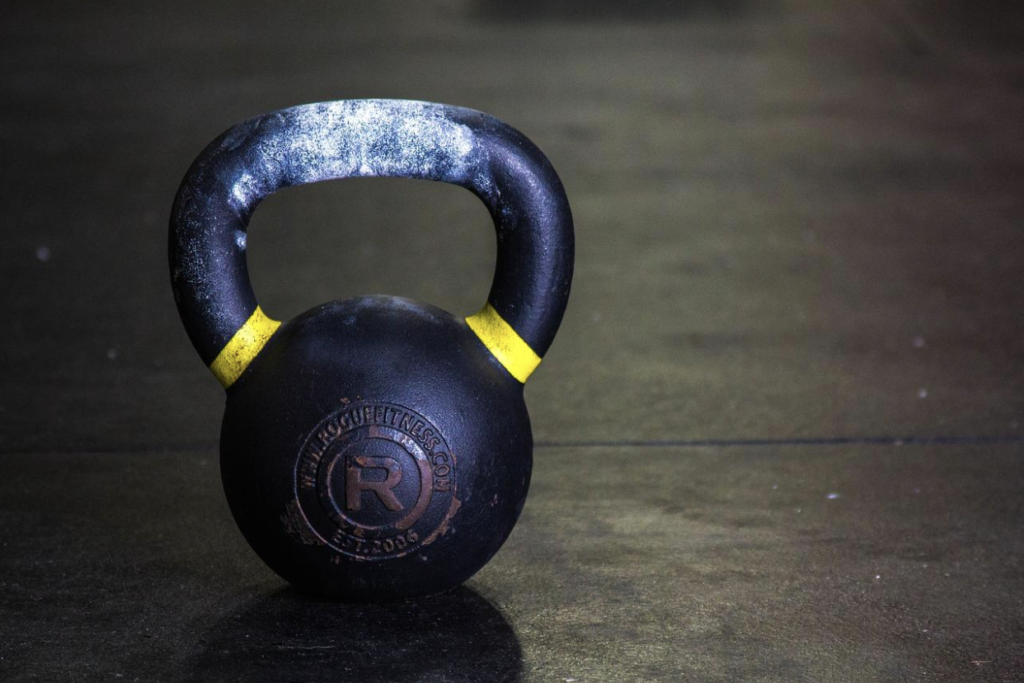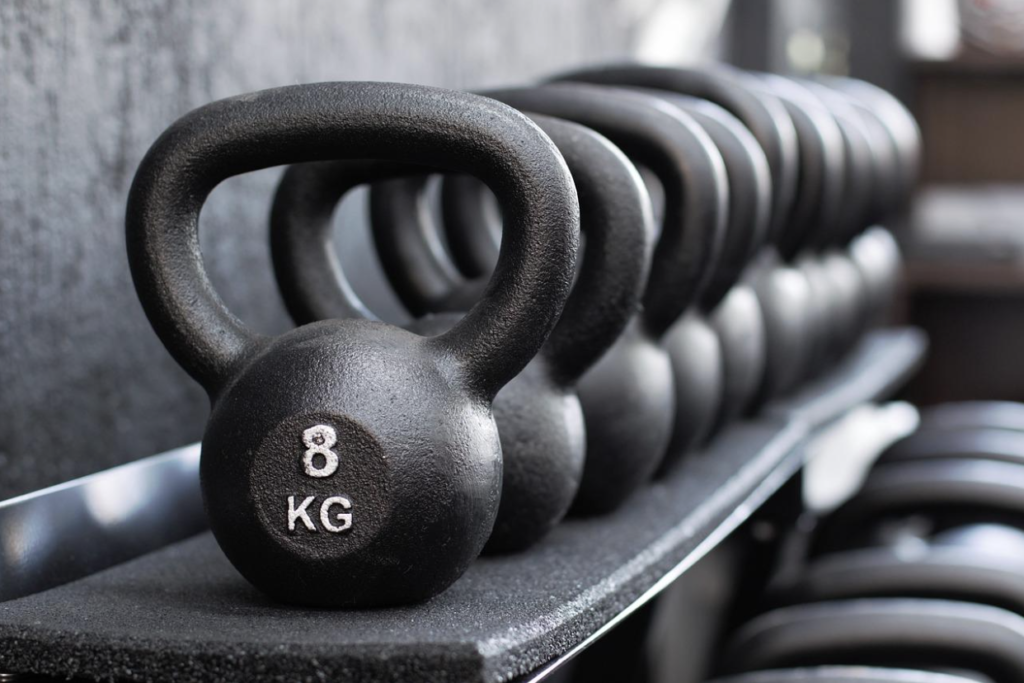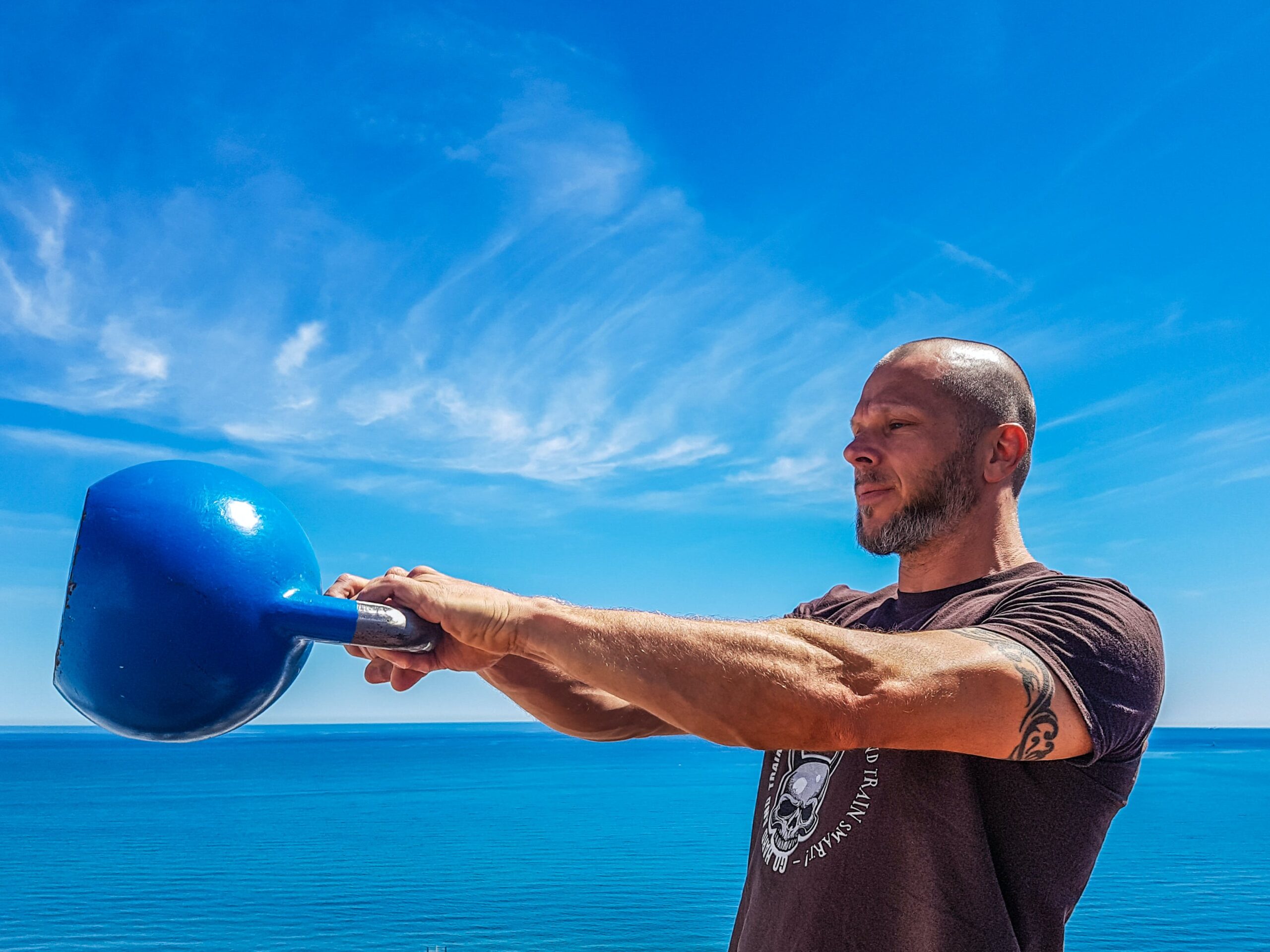Do you feel less confident seeing your weak arms? You might have considered going to the gym for a workout, but what if we tell you that instead of doing some regular arms workout, there’s a much better way to transform those weak arms into attractive-looking, powerful biceps?
A kettlebell workout has proved to be the most effective and easiest way to gain shoulder and upper body strength. This post will teach you how to do a kettlebell workout from scratch. So, let’s get started with our transforming biceps journey.
Table of contents
Introduction
We’ll start with the basics of kettlebell biceps exercise. Kettlebell bicep workouts are simple and effective moves targeting your biceps effectively. The most straightforward exercise involves taking two kettlebells, extending your arms fully, and then curling them up smoothly toward your shoulders.
If you feel the weight is heavy, lower it. Once you have targeted both your arms correctly, it’s time to do more kettlebell exercises that will engage your back and lower body muscles.

Benefits of Kettlebell Biceps Exercises
Before discovering various kettlebell exercises, let’s find out the benefits associated with these exercises.
- Simple and Effective
First of all, they’re simple and highly effective. You can do it easily. It’s like a wave to your muscles. No need for a gym science degree; just get those kettlebells and start moving.
- All Muscles Are Involved
Besides being great for your biceps, it’s suitable for everything. As you exercise, other muscles, including your forearms and shoulders, also participate, which means you are strengthening all the muscles.
- Require Less Time
You don’t have to spend much time working out your biceps with kettlebells. Kettlebells give you a good workout in a short period. Getting fit in this way is like going fast.
What’s more? You can change things up, keep it interesting, and surprise your muscles. Boredom? Not on the guest list.
So, in a nutshell, it’s simple, quick, inclusive, and versatile. Exercises that involve kettlebells for biceps are like endless presents for fitness enthusiasts!

7 Best Kettlebell Biceps Exercises
Let’s discover different kettlebell biceps exercises.
Kettlebell Preacher Curls
Imagine using a preacher’s bench but with a kettlebell.
- Place your upper arms on a bench or a ball while holding a kettlebell in each hand.
- Squeeze your biceps with the weights as you lift them toward your shoulders.
- This exercise allows you to isolate your muscles and grow them more effectively.
Kettlebell Goblet Squats
It is an exciting exercise.
- Get into a squatting position while holding a kettlebell. Ensure your hips and knees bend correctly, and your back is straight. Also, ensure that your knees are well aligned with your toes. See that if your whole body is engaging and you are doing it in a well-aligned manner.
- Once you finish sets, stand up while contracting your glutes.
- You will feel that your whole body participated in this workout. How amazing is that?
The Reverse Bottom-Up Curl with Kettlebells
- Hold the kettlebell bottoms up (upside down), with the handle between the forearms and the hands wrapped around the bell.
- Perform a bicep curl by slowly lowering the kettlebell.
- As elbows reach full extension, reverse the pattern and curl the weight to the chest.
Reverse bottoms-up kettlebell curls offer several benefits, increasing bicep activation and hypertrophy. This variation prohibits the lifter from completely straightening arms or curling them excessively at the top to prevent dumping the load. Biceps are tense due to this lock-in, with no relaxation and maximal activation.
Kettlebell Lunges
- Start by holding a kettlebell in each hand at your sides for Kettlebell Lunges.
- You should stand with your feet hip-width apart.
- Step forward with one leg, ensuring both knees form a 90-degree angle. The back knee should hover just above the ground. To maintain balance, make sure you engage your core.
- Bring both feet together as you return to your starting position by pushing off the front foot.
- Repeat the lunge on the other side by alternately alternating legs.
- The quadriceps, hamstrings, and glutes are targeted in kettlebell lunges, an effective lower-body exercise.
Adding kettlebells to the workout intensifies the challenge, making it a rewarding strength-building exercise.
Kettlebell Rows
- Stand with your feet open and your shoulders wide apart to perform kettlebell rows.
- Start by holding the kettlebell in your hands, and extend both your arms while hinged at your hips.
- While doing so, tense up your shoulder blades together, as your elbows should be bending.
- Now, bring the kettlebell upwards towards your chest. Doing this will make you feel your back muscles engage in this workout. Maintain your balance and let those back muscles fully participate.
- Now, move back your arms while holding the kettlebell in a controlled way.
This exercise can help you gain back muscles as well as shoulder strength.
Kettlebell Zottman Curls
- With the Zottman curl, combine regular and reverse curls.
- Lift the kettlebell toward your shoulders while keeping your palms facing up as you perform a regular curl.
- Initially, curl the kettlebell, but twist the wrists when lowering it.
- Performing this exercise works several muscles, enhancing the strength of your arms.
In this exercise, your biceps, forearms, and brachialis are worked both upward and downward. You can strengthen and define your arms with the Zottman Curl, which targets various muscle groups in the arms.
The exercise should be performed with controlled movements to maximize its effectiveness. The Kettlebell Zottman Curl can contribute to well-rounded arm development.
Kettlebell Deadlifts
When it comes to strengthening your lower body and core, kettlebell deadlifts are a great exercise. Effectively performing this exercise requires the following:
- Stand with your feet hip-width apart, ensuring the kettlebell is positioned right between your feet. For the exercise to be successful, a stable base is necessary.
- Hinge at your hips, pushing them backward while slightly bending your knees to begin the movement. Your lower back should remain straight and not rounded at all times.
- Reach down and firmly grasp the kettlebell handle with both hands. It is essential that your grip is secure and that your palms face you when you hold the weapon. Through this grip, the lift will be adequately controlled.
- Engage your glutes and hamstrings as you lift the kettlebell. As you lift the kettlebell, straighten your knees and hips simultaneously. For optimal movement, keep the kettlebell close to your body.
Maintain a straight back throughout the lift. To prevent unnecessary stress on your lower back, avoid rounding your spine. Keeping your core muscles engaged helps stabilize and protect your spine.
What should be the “Sets” Frequency Range for Kettlebell Biceps Exercises?
There’s nothing different you should do with kettlebell sets workout. If you’re blanked out with how many sets you should perform with each kettlebell, here are some simple suggestions:
- Three sets of 10 reps for the Hammer Curl
- 3-4 sets of 8-12 repetitions of kettlebell lunges
- Taking 20 seconds rest between sets after each set, do 12 sets of 8-10 reps of kettlebell press.
- For kettlebell rows: 6 to 12 reps
- When performing kettlebell deadlifts, 5 – 12 reps for one or two sets.
- For kettlebell Zottman curls: 10-12 reps and then do 3-4 sets.
It is OK to adjust the reps based on the kettlebell weight. Keep your form good while pushing yourself to near failure (a couple of reps left in the tank) with each set. As your sets progress, you may do fewer reps.
Sets can also be adjusted. 10-12 sets will be enough to exhaust your muscles fully so that you can do two instead of three. Alternatively, you can increase the number of sets. By the end of the workout, your biceps should be fully exhausted.
What Should the Weight of a Kettlebell Be?
Light weights are best for a beginner with little or no lifting experience. The problem with keeping it too light is that it fails to engage the correct muscles. Accordingly, experts recommend a kettlebell weight of 26 lbs. to 53 lbs. for beginners. It’s best to start around 16lbs to 35lbs for female counterparts.
Those with some or considerable experience with weight training can pick weights between 53lbs and 70lbs if they are familiar with weight training. Women can choose between 35lbs and 53lbs.
It depends mainly on your age, strength, and exercise goals. For this reason, you should speak with a gym instructor to determine the right kettlebell size for you.
Important Considerations for Kettlebell Biceps Exercises
There are a lot of options when it comes to kettlebell workouts. They can be swung, lifted, or even used while sitting. It’s like having a box filled with tools, and every time you exercise, you get to pick out a new one.
There are different ways to use kettlebells to keep your muscles active. It’s a variety pack for exercising. As a result, your muscles remain challenged and grow stronger.
So, when you see the kettlebells, consider them your fitness toolbox. It’s a great way to mix things up, try new exercises, and make your workout more enjoyable. You have a whole menu of exercises, and you pick what works best for you!
- More Movement
It’s good for your muscles to do kettlebell exercises. Unlike regular lifting, they require more movement. In a sense, it adds some variety to your workouts.
You’re putting your body through a lot of extra work. It makes you more flexible, like a gymnast doing cool flips. The joints in your body, like hinges, also benefit from this exercise. It’s like giving them a nice oiling, keeping them smooth and happy.
- Use the Right Weights
Be sure to choose kettlebells that are tough yet manageable. You can increase the weight for a more challenging workout as you get stronger. It’s all about finding the sweet spot for your strength.
- Pay Attention to How You Move
Take note of how you perform each exercise. Avoid rushing, move deliberately, and don’t use force when standing or sitting up straight. If you pay attention to your form, you’ll get the most from your kettlebell biceps workout.
FAQs for Kettlebell Biceps Exercises
Kettlebell biceps exercises are simple, effective, and time-efficient, engaging not just the biceps but also the forearms, shoulders, and other muscles. They offer a versatile workout that prevents boredom and promotes overall muscle strength and fitness.
Absolutely! One of the great advantages of kettlebell exercises is their simplicity and versatility, allowing you to perform them anywhere, including at home, with minimal equipment.
A simple and effective starter exercise is the kettlebell curl. Hold two kettlebells with arms extended, then curl them smoothly toward your shoulders. Adjust the weight as needed to ensure proper form and comfort.
The blog outlines seven effective kettlebell exercises for biceps, including preacher curls, goblet squats, and reverse bottom-up curls. Incorporating a variety of these exercises into your routine can provide a comprehensive bicep workout.
Generally, aim for 3-4 sets of 8-12 repetitions for each exercise, with rest periods of about 20 seconds between sets. Adjust the number of sets and reps based on your fitness level and the kettlebell weight.
Beginners should start with lighter weights (16lbs to 35lbs for women and 26lbs to 53lbs for men) and gradually increase as strength improves. The right weight should challenge your muscles without compromising form.
Yes, kettlebell exercises can be adapted for any fitness level. Beginners should start with lighter weights and simpler movements, while more experienced individuals can increase the weight and complexity of the exercises.
Yes, the dynamic nature of kettlebell exercises can enhance flexibility and joint mobility, making them beneficial not just for muscle strength but also for overall physical health.
Choose appropriate weights, focus on proper form, and incorporate a variety of movements to engage different muscle groups. Paying attention to these factors can maximize the effectiveness of your workout and reduce the risk of injury.
For best results, integrate kettlebell biceps exercises into your routine 2-3 times per week, allowing for rest days in between to support muscle recovery and growth.
Conclusion
Great job! Your kettlebell biceps workout is now complete. Regularly including these exercises in your routine will make your arms stronger and more attractive. Don’t give up, and you’ll soon have attention-grabbing arms. It’s time to show off those well-defined biceps!

1 thought on “Get Strong Arms with Kettlebell Biceps Exercises”